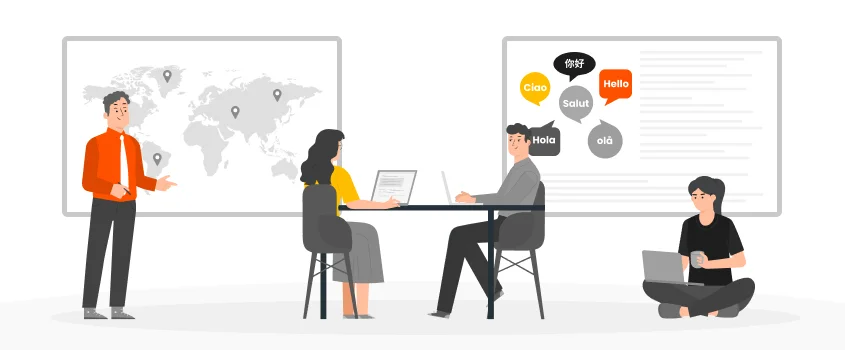What is the difference between Translation and Localization?
By: Peter Edward Posted on Wed, 04-09-2019

2025 Offer Request a Quote Today and Grab a $50 Coupon for Free!
By: Peter Edward Posted on Wed, 04-09-2019

In this era of globalization, terms translation and localization are being used reciprocally. The global world considers these two words similar to little variation. Here question rises why we need to care about these two words? Answer can be well understood by European Commission Survey which states that 52% and 85% of internet users said that they only view content on the internet if it is in their own language.
This survey gives the importance of native language. Furthermore, if you want language should have an impact on consumers and make web visitors to consumers than your content should be according to the culture of the society. In order to compete and expand your business globally, it is necessary to modify website and digital media content according to global audience. Many big and small companies need to understand the difference between translation and localization. Let’s see what translation and localization is about.
Translation is the process of changing a source version into target language. It can also be defined as literal word-for-word conversion from source version into target language. If purchaser want to know how to use product than it must be essential that source and target language should join up precisely.
Localization is the process of translating the content according to the locale and culture of the society. Context should be according to particular locale and cultural settings which makes it easily understandable for local native speakers. Making your product culturally and linguistically attracted for regional market where it can be sold is known as localization.
|
Translation |
Localization |
|
Changes source version into target language |
Adaption of content according to local culture |
|
Focuses more on the literally meanings |
Adapts according to cultural and functional demands |
|
Neutral in Cultural differences |
Meets cultural and functional demands |
Translation is the gateway to remove communication barriers. It delivers the meaning by altering the words in one language to another. It focuses on literal meanings and delivers the accurate meaning in the target language. Translation is used for writing manuals, medical, legal and technical publications, scientific journals and literature reviews. Translation must be accurate so that the original message in the target language does not alter its meaning.
Contrary to translation localization is used for content for websites, mobile apps, software, multimedia content and voiceovers. Localization is adapting your message according to local, regional and linguistic requirements. Every country has different culture and norms.
Words, colors cultural symbols and other cultural connotations plays very important role in localization. If you need to develop marketing content for Mexico and Spain although both of these countries have Spanish as their official language just as English dialect is different in US to Australia and Canada so local version and regional dialect needs to be considered while developing your marketing content.
Translation is the first step towards localization process so it is important to hire a professional team of translators who can localize efficiently. You also need to work with local markets to know the cultural aspects and local laws for proper localization. For example while content localization you cannot use green color in Indonesia as it is forbidden there however you can use this green color in Mexico.
In case of words you cannot use gift in German language as Gift in German language means poison. As far as clothing is concerned Women in Arab countries have to wear hijab scarves and burqa to cover their bodies. Same attire cannot be followed in western world. All these requirements must be taken into account while localizing your content. Proper images and graphics should be used in online content.
To cater a multilingual and diverse consumer base content of your e-commerce website must be localized. Needs and wants of every customer is different according to their culture and region. Consumer behavior needs to be understood in order to cater target audience properly. Cultural differences includes visuals, icons, colors and social codes that are symbols and currencies.
In order to localize your content functional factors should also need to be considered. Functional elements include specification and description of product and services, addresses date and time formats, and phone numbers. Need of the hour is to consider cultural and functional factors while localizing your online content. Coca-Cola sustain single message globally while adhering to local markets.
Everyone knows the brand color of the company whether one is living in different corners of the world but their marketing strategy is different in every country according to the cultural and functional demands of the target audience. In China, company changed its name to ‘kekou kele which means delicious happiness in order to maintain its brand voice. Their local strategy helped them in targeting china’s market. . It was not just about translating content and changing label, they sold the brands image after doing research in local market.
Translation deals with technical subjects which needs subject matter experts of medical legal finance and science. If you want to get your online training material standardized, you can opt for translation. Localization is recommended for highly emotional content which includes marketing and website content. If you want to provide customized services according to region and culture than you can go for localization. This can be done for trainings and web content.
Emotional part of localization is that content which is developed while considering local and culture aspects of society moves the heart of the consumers and helps them in making rational purchasing decisions.
In this global world translation alone will not help you reaching your target audience. You have to localize according to local traditions. People will buy your product if they understand your message according to their needs and wants. To increase Consumer engagement, you need to make such marketing strategy who fulfills the expectations of local people. Thus investment in translation and localization will help you grow your business around the globe.
Read More: Difference Between Translation and Transliteration

Language variations are quite noticeable every few miles, reflecting the unique identity of each region. Talking about India, the country
Read more
The term ‘woke’ has come from the black culture and now it has been removed from its origin after it
Read more
Mars Translation provides high quality and professional Certified French Translation Services all over the world. We have a team of
Read more
Mars Translation provides one of a kind professional Chinese Document translation services all over the world. All of MT’s translators
Read more
MarsTranslation provides one of a kind Chinese Legal Translation Services. We have a team of native Chinese linguist who specialize
Read more
Chinese Certified Translation services is one of the most asked for service at MarsTranslation. We believe in providing quality services
Read more
Mars Translation is one of the fastest growing companies in the translation industry. This is the reason why we pay
Read more
MarsTranslation has a huge team of website translation specialists in more than 230 languages. Our translators are constantly supported by
Read more
Mars Translation provides high quality and professional Certified Spanish Translation Services all over the world. We have a team of
Read more

